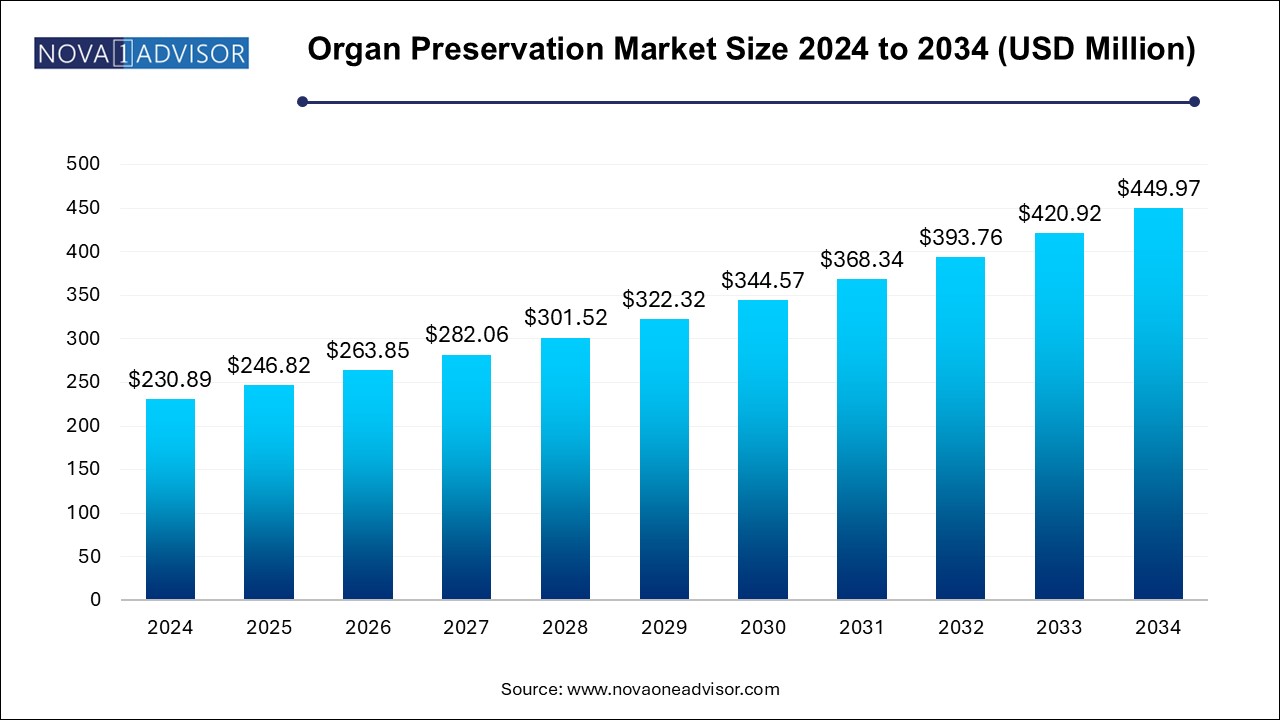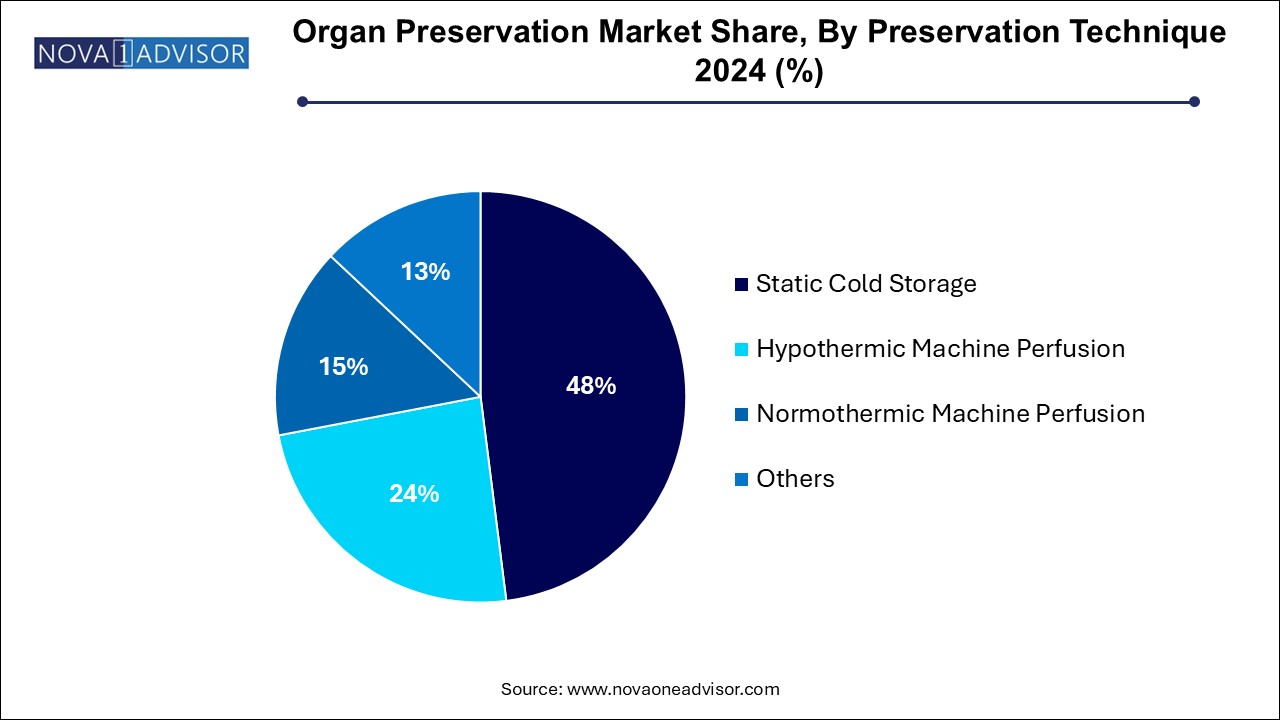Organ Preservation Market Size and Growth
The organ preservation market size was exhibited at USD 230.89 million in 2024 and is projected to hit around USD 449.97 million by 2034, growing at a CAGR of 6.9% during the forecast period 2024 to 2034.

Organ Preservation Market Key Takeaways:
- Perfadex segment is anticipated to witness the fastest CAGR over the forecast period.
- The kidney segment held the largest market share in 2024.
- The heart segment is anticipated to witness the fastest CAGR over the forecast period.
- The static cold storage segment held the largest share in 2024 owing to its wide applicability and increase in use.
- The normothermic machine perfusion segment is anticipated to witness the fastest CAGR over the forecast period.
- North America held the largest market share in 2024 and is expected to maintain its dominance over the forecast period.
- Asia Pacific is anticipated to witness the fastest growth over the forecast period.
Market Overview
The organ preservation market is a critical segment within the organ transplantation ecosystem, ensuring that organs remain viable between procurement and transplantation. Successful transplantation outcomes depend heavily on the quality and viability of preserved organs, making effective preservation methods and solutions indispensable.
Organ preservation involves a combination of specialized solutions, temperature regulation techniques, and mechanical devices designed to maintain organ integrity and function during transport and prior to implantation. The global increase in organ transplant procedures, driven by the rising burden of chronic organ diseases like end-stage renal disease, liver cirrhosis, and heart failure, is significantly driving the demand for advanced preservation technologies.
In addition to growing transplant volumes, technological innovation in preservation techniques including hypothermic machine perfusion (HMP) and normothermic machine perfusion (NMP) is reshaping traditional methods like static cold storage (SCS), offering enhanced graft viability and extended preservation times.
Furthermore, government initiatives promoting organ donation awareness, expanded donor pools including marginal donors, and efforts to reduce organ wastage are contributing to the growing demand for high-quality preservation solutions worldwide. As a result, the organ preservation market is poised for substantial expansion in the coming years.
Major Trends in the Market
-
Shift Toward Machine Perfusion Technologies: Increasing adoption of hypothermic and normothermic machine perfusion over traditional static cold storage.
-
Rising Use of Marginal and Expanded Criteria Donors: Driving demand for enhanced preservation techniques to optimize suboptimal donor organs.
-
Development of Specialized Preservation Solutions: Customized fluids targeting specific organ requirements (e.g., Custodiol HTK, Perfadex).
-
Integration of Real-time Organ Monitoring: Advances in perfusion machines allowing real-time assessment of organ viability pre-transplantation.
-
Focus on Prolonged Preservation Times: Research into extending organ viability beyond traditional 24-hour windows to address logistical challenges.
-
Public-Private Partnerships Promoting Organ Donation Programs: Especially in emerging economies, expanding the donor base.
-
Increased R&D in Normothermic Perfusion: Moving closer to clinical mainstream adoption across multiple organ types.
-
Expansion into Asia-Pacific Markets: Rising healthcare investments and growing transplant infrastructure in emerging countries.
Report Scope of Organ Preservation Market
| Report Coverage |
Details |
| Market Size in 2025 |
USD 246.82 Million |
| Market Size by 2034 |
USD 449.97 Million |
| Growth Rate From 2024 to 2034 |
CAGR of 6.9% |
| Base Year |
2024 |
| Forecast Period |
2024-2034 |
| Segments Covered |
Solution, Organ Type, Preservation Technique, and Region |
| Market Analysis (Terms Used) |
Value (US$ Million/Billion) or (Volume/Units) |
| Regional Covered |
North America; Europe; Asia Pacific; Latin America; MEA |
| Key Companies Profiled |
XVIVO Perfusion; TransMedics; 21st Century Medicine; CryoLife, Inc.; Bridge to Life Ltd. |
Key Market Driver: Rising Global Burden of Chronic Diseases Leading to Increased Organ Transplants
The most prominent driver for the organ preservation market is the rising global burden of chronic diseases leading to increased organ transplantation procedures.
Diseases such as chronic kidney disease (CKD), liver cirrhosis, congestive heart failure, and chronic obstructive pulmonary disease (COPD) are escalating globally due to aging populations, lifestyle-related risk factors, and increasing incidences of diabetes and hypertension. As end-stage organ failure becomes more prevalent, the demand for organ transplants rises dramatically.
Successful organ transplantation depends not only on surgical expertise but also on the ability to preserve organs effectively from the point of donation to implantation. Therefore, the growing number of transplantations particularly kidney, liver, heart, and lung directly correlates with heightened demand for advanced preservation techniques and solutions.
Key Market Restraint: High Cost and Limited Availability of Advanced Preservation Technologies
A significant restraint facing the market is the high cost and limited availability of advanced preservation technologies, particularly in low- and middle-income countries.
Advanced preservation techniques such as hypothermic and normothermic machine perfusion require expensive equipment, specialized preservation solutions, and highly trained personnel. These systems represent a substantial investment for healthcare facilities already burdened with high transplantation costs.
Additionally, the uneven distribution of transplant infrastructure means that many healthcare centers in emerging regions still rely heavily on traditional static cold storage methods, limiting the adoption of superior yet costlier machine-based techniques. Bridging affordability gaps through innovation and policy support will be critical to overcoming this restraint.
Key Market Opportunity: Expansion of Normothermic Machine Perfusion (NMP) Applications
An emerging and transformative opportunity lies in the expansion of normothermic machine perfusion (NMP) applications across multiple organ types.
Normothermic perfusion technology maintains donor organs at physiological temperatures with oxygenated blood or perfusate, enabling metabolic activity to continue during preservation. This technique allows for better assessment of organ function, repair interventions before transplantation, and extended preservation windows compared to cold storage.
Initially developed for liver and heart preservation, NMP is now being investigated and clinically adopted for kidneys and lungs, broadening its market potential. Companies investing in NMP platforms and research collaborations stand to capture a significant share of the growing preference for dynamic, superior organ preservation methods.
Organ Preservation Market By Solution Insights
University of Wisconsin (UW) solution dominates the solution segment, widely recognized as the gold standard for preserving kidneys, livers, and pancreases. It is the most extensively studied and utilized static cold storage solution, offering effective protection against ischemia-reperfusion injury during transplantation.
Perfadex is growing fastest, particularly in the preservation of lungs. Perfadex’s unique low-potassium, dextran-based composition offers superior endothelial protection and anti-edema properties, enabling longer lung preservation times. With lung transplantation becoming more prevalent globally, especially for conditions like cystic fibrosis and pulmonary fibrosis, Perfadex's adoption rate continues to climb rapidly.
Organ Preservation Market By Organ Type Insights
Kidney preservation dominates the organ type segment, reflecting the high volume of kidney transplants performed globally. Kidney transplants account for over 60% of all solid organ transplants, primarily due to the widespread burden of end-stage renal disease (ESRD) and the established success rates of renal transplantation.
Heart preservation is growing fastest, driven by improved heart transplant outcomes, expanding donor pools through better organ preservation, and the emergence of ex vivo perfusion systems that allow functional evaluation of donor hearts. Technological advancements enabling extended heart preservation times are transforming traditionally time-sensitive heart transplantation logistics.
Organ Preservation Market By Preservation Technique Insights
Static cold storage (SCS) dominates the preservation technique segment, remaining the most commonly used method globally due to its simplicity, low cost, and adequate efficacy for many organ types under standard conditions.

Normothermic machine perfusion (NMP) is growing fastest, offering superior graft preservation, real-time functional assessment, and the possibility of organ repair prior to transplantation. As clinical evidence supporting NMP’s benefits accumulates, its adoption is expanding beyond experimental and trial settings into routine clinical practice.
Organ Preservation Market By Regional Insights
North America holds the largest share of the global organ preservation market, driven by high transplant volumes, advanced healthcare infrastructure, and strong adoption of innovative preservation technologies.
The United States accounts for the majority of regional revenue, supported by extensive organ donation networks like UNOS (United Network for Organ Sharing), robust funding for transplantation research, and widespread clinical usage of hypothermic and normothermic perfusion technologies.
Additionally, favorable reimbursement policies and the presence of leading organ preservation solution and device manufacturers strengthen North America’s leadership position.
Asia-Pacific is the fastest-growing region, fueled by rising prevalence of chronic diseases, expanding transplant infrastructure, and improving healthcare access in countries like China, India, Japan, and Australia.
Government initiatives to promote organ donation, increasing healthcare investments, and growing awareness about advanced transplant practices are accelerating regional market growth. The expansion of living donor transplantation programs and the adoption of machine perfusion techniques in select Asian transplant centers further drive market momentum.
Some of the prominent players in the organ preservation market include:
- XVIVO Perfusion
- TransMedics
- 21st Century Medicine
- CryoLife, Inc.
- Bridge to Life Ltd.
Recent Developments
-
March 2025: TransMedics Group announced FDA approval of its Organ Care System (OCS) Heart for broader use in DCD (donation after circulatory death) heart transplantation procedures.
-
February 2025: XVIVO Perfusion AB launched its XPS™ Lung Preservation System with upgraded real-time lung evaluation capabilities across Europe.
-
January 2025: Bridge to Life Ltd. announced the acquisition of assets from a U.S.-based NMP startup, strengthening its position in dynamic organ preservation technologies.
-
December 2024: Paragonix Technologies secured expanded FDA clearance for its SherpaPak™ Cardiac Transport System, offering enhanced cardiac graft preservation during long-distance transports.
-
November 2024: OrganOx Ltd. reported successful clinical trial results for its metra® liver perfusion device, supporting extended normothermic preservation up to 24 hours.
Segments Covered in the Report
This report forecasts revenue growth at country levels and provides an analysis of the latest industry trends in each of the sub-segments from 2021 to 2034. For this study, Nova one advisor, Inc. has segmented the organ preservation market
By Solution
- University of Wisconsin (UW)
- Custodial HTK
- Perfadex
- Others
By Organ Type
- Kidneys
- Liver
- Lung
- Heart
- Others
By Preservation Technique
- Static Cold Storage
- Hypothermic Machine Perfusion
- Normothermic Machine Perfusion
- Others
By Regional
- North America
- Europe
- Asia Pacific
- Latin America
- Middle East and Africa (MEA)


